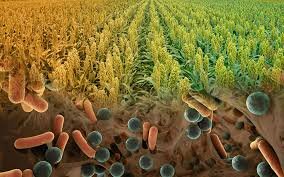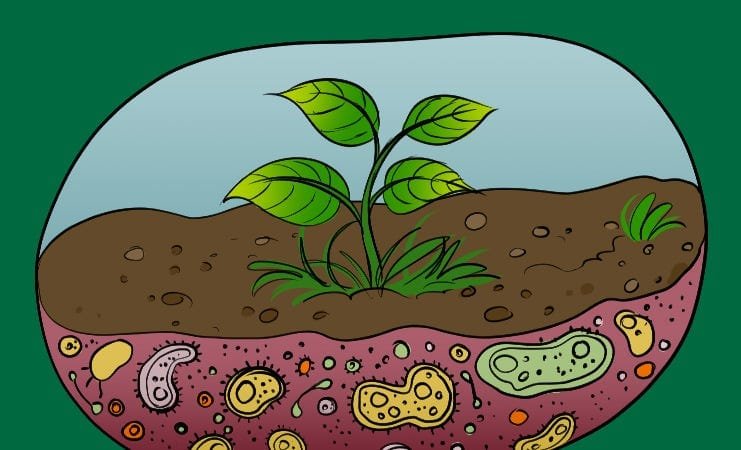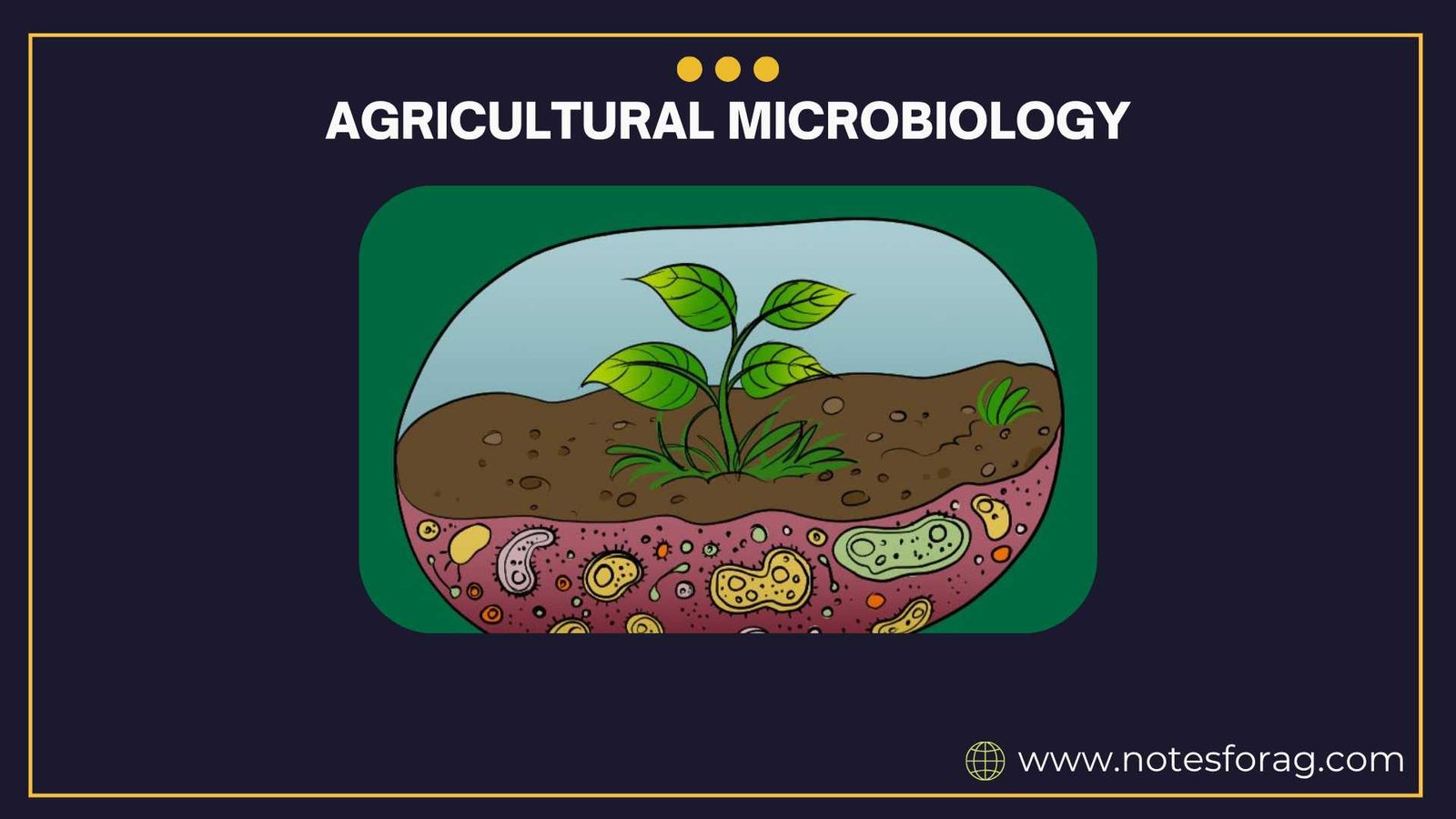Introduction

Agricultural Microbiology is a branch of science that focuses on the role of microorganisms in agriculture. It includes the study of soil fertility, plant health, microbial diversity, and the interaction between microbes and plants. These microbes can be both beneficial and harmful, and their influence plays a vital role in food production, crop protection, and environmental sustainability. Understanding agricultural microbiology is essential for improving soil health, enhancing crop yields, and ensuring sustainable agricultural practices.
Summary of Agricultural microbiology
- Beneficial microbes like Rhizobia, Azotobacter, and mycorrhizal fungi naturally improve nutrient cycling, boost soil fertility, and enhance crop productivity.
- Microorganisms such as Bacillus amyloliquefaciens and Trichoderma act as eco-friendly biopesticides, reducing dependence on chemical pesticides by suppressing harmful pathogens.
- Despite their benefits, microbial products vary in effectiveness across environments, requiring customized formulations, stringent quality control, and deeper research into plant–microbe interactions.
Table of Contents
Scope and Importance of Agricultural Microbiology
Enhancing Soil Fertility
Microorganisms help decompose organic matter, fix atmospheric nitrogen, and mobilize essential nutrients, improving soil structure and fertility. They contribute to the nutrient cycles and help plants absorb minerals like phosphorus, potassium, and iron efficiently.
Plant Growth Promotion
Certain bacteria and fungi act as biofertilizers by producing plant hormones, increasing nutrient uptake, and protecting against pathogens. These include plant growth-promoting rhizobacteria (PGPR) and mycorrhizal fungi, which enhance plant vigor.
Biological Control of Pests and Diseases
Beneficial microbes can suppress plant pathogens and pests by producing antibiotics, enzymes, and toxins or by outcompeting harmful organisms. This method, known as biocontrol, is a sustainable alternative to chemical pesticides.
Decomposition and Organic Matter Recycling
Microorganisms play a critical role in decomposing plant residues, animal waste, and organic fertilizers. This helps recycle nutrients into the soil and reduces the need for synthetic inputs.
Bioremediation and Pollution Control
Microbes can degrade harmful agricultural chemicals and pollutants, making them useful in cleaning contaminated soils and water bodies. This process contributes to environmental conservation and safer food production.
Classification of Agricultural Microorganisms
1. Bacteria

These are single-celled prokaryotic organisms that perform various functions such as nitrogen fixation, phosphate solubilization, and organic matter decomposition. Examples include Rhizobium, Azotobacter, and Bacillus.
2. Fungi
Fungi are multicellular or unicellular organisms that include beneficial forms like mycorrhizae and harmful ones like plant pathogens. Mycorrhizal fungi enhance water and nutrient uptake, especially phosphorus.
3. Actinomycetes
These are filamentous bacteria that resemble fungi and are found in soil. They are important for breaking down tough organic materials and producing antibiotics that control soil-borne diseases.
4. Algae
Microscopic algae like blue-green algae (cyanobacteria) contribute to nitrogen fixation, especially in paddy fields. They also improve soil texture and add organic carbon.
5. Viruses
Plant viruses are pathogens that infect crops, causing diseases. Although harmful, their study is essential for managing viral outbreaks in agriculture through resistant varieties and integrated pest management.
Soil Microbiology and Its Role in Agricultural Microbiology
Microbial Diversity in Soil
Soil hosts a diverse range of microorganisms, including bacteria, fungi, protozoa, and nematodes. This microbial diversity is crucial for maintaining healthy soil ecosystems.
Nutrient Cycling
Soil microbes help in the transformation and movement of nutrients like nitrogen, phosphorus, sulfur, and carbon through biogeochemical cycles. This supports plant growth and long-term soil productivity.
Biofertilizers

These are formulations containing live microbes that enrich the soil with nutrients. Examples include nitrogen-fixing bacteria (Rhizobium), phosphate-solubilizing bacteria (Pseudomonas), and potassium-mobilizing bacteria.
Rhizosphere Interactions
The rhizosphere is the zone around plant roots where intense microbial activity occurs. Here, microbes and plant roots exchange nutrients and signaling molecules, fostering mutual growth.
Beneficial Microorganisms in Agricultural microbiology
Nitrogen-Fixing Microbes
These microbes convert atmospheric nitrogen into ammonia, a form usable by plants. Examples include:
- Rhizobium (symbiotic with legumes)
- Azospirillum (free-living)
- Frankia (associated with non-legume plants)
Phosphate-Solubilizing Microorganisms (PSMs)
These bacteria and fungi solubilize insoluble phosphates in the soil, making them available to plants. Examples are Bacillus megaterium and Aspergillus niger.
Mycorrhizal Fungi
These fungi form symbiotic relationships with plant roots, enhancing nutrient and water uptake. Arbuscular mycorrhizal fungi (AMF) are the most common and are crucial for phosphorus nutrition.
Plant Growth-Promoting Rhizobacteria (PGPR)
PGPR colonize plant roots and promote growth by producing phytohormones, inducing systemic resistance, and improving nutrient acquisition. Pseudomonas fluorescens is a well-known PGPR.
Antagonistic Microbes
These organisms inhibit the growth of plant pathogens through competition, antibiosis, or parasitism. Trichoderma species are widely used as biocontrol agents.
Microbial Biotechnology in Agriculture
Genetic Engineering of Microbes
Genetically modified microbes are used to enhance nutrient availability, pest resistance, or stress tolerance in crops. Engineered strains can produce biofertilizers more efficiently or degrade toxins more effectively.
Microbial Bio-pesticides
Bio-pesticides are derived from microbial agents that target specific pests. They are eco-friendly and include products based on Bacillus thuringiensis (Bt) for insect control.
Composting and Vermicomposting
Microbes aid in the decomposition of organic waste into nutrient-rich compost. Vermicomposting uses earthworms and microbes to accelerate the process and produce high-quality organic manure.
Fermentation Technology
Microbial fermentation is used to produce agricultural inputs like biofertilizers, enzymes, and organic acids. It is also employed in the food processing industry for items like yogurt and pickles.
Harmful Microorganisms in Agricultural microbiology
Pathogenic Bacteria
These cause diseases in crops and reduce yield. Examples include Xanthomonas (bacterial blight in rice) and Erwinia (soft rot in vegetables).
Fungal Pathogens
Fungi like Fusarium, Alternaria, and Phytophthora cause wilts, rots, and blights, leading to significant agricultural losses.
Viral Infections
Viruses such as the Tobacco Mosaic Virus (TMV) and Tomato Yellow Leaf Curl Virus (TYLCV) infect crops and are often transmitted by insect vectors like aphids and whiteflies.
Parasitic Nematodes
These microscopic worms infect plant roots, leading to reduced nutrient and water absorption. Root-knot nematodes (Meloidogyne spp.) are particularly destructive.
Integrated Microbial Management
Combining Beneficial Microbes
Using a consortium of biofertilizers, biopesticides, and composting microbes enhances soil fertility and crop protection synergistically.
Organic Farming Practices
Organic agriculture heavily relies on microbial inputs for soil enrichment and pest control. It avoids synthetic chemicals, promoting ecological balance.
Monitoring and Quality Control
Ensuring the viability and effectiveness of microbial products is essential. This includes testing for microbial count, contamination, and performance before field application.
Challenges and Future Prospects
Challenges in Agricultural Microbiology
- Lack of awareness among farmers
- Limited availability of quality microbial products
- Inconsistent performance in different field conditions
Future Directions
- Development of region-specific microbial formulations
- Use of AI and machine learning to predict microbial interactions
- Expansion of microbial seed coating technologies
- Greater integration with precision agriculture
Conclusion
Agricultural Microbiology is fundamental to sustainable farming and environmental protection. By leveraging the power of beneficial microbes, farmers can reduce their reliance on chemical inputs, enhance soil health, and increase crop productivity. Despite challenges, advancements in microbial biotechnology, education, and policy support can help unlock the full potential of microbes in agriculture. As we face climate change and food security issues, agricultural microbiology offers eco-friendly and innovative solutions for future farming systems.
Frequently Asked Questions (FAQs)
What is agricultural microbiology and why is it important?
Agricultural microbiology studies how soil microorganisms affect plant growth, pest control, and nutrient cycling. Leveraging these microbes helps reduce chemical inputs and improves sustainable crop production. It plays a key role in promoting eco-friendly farming by enhancing soil health, reducing pollution, and increasing agricultural resilience.
How do biofertilizers work and what are common types?
Biofertilizers use live microbes (e.g., Rhizobium, Azotobacter, cyanobacteria) to fix atmospheric nitrogen or solubilize phosphorus, enriching soil nutrients naturally. They are low-cost, eco-friendly alternatives to synthetic fertilizers.
Common types include nitrogen-fixing, phosphate-solubilizing, and mycorrhizal biofertilizers, each targeting specific soil deficiencies to improve crop productivity.
What role do microbial biopesticides play in farming?
Microbial biopesticides such as Bacillus and Trichoderma species attack plant pathogens through competition or toxins, offering targeted pest control without harming beneficial organisms or the environment. They are safe for humans and wildlife, and help farmers shift toward integrated pest management practices that support long-term soil health.
Can microbes improve soil quality and crop yields?
Yes. Soil microbes decompose organic matter, cycle vital nutrients like nitrogen and phosphorus, and support plant growth-promoting rhizobacteria (PGPR), leading to healthier soils and higher yields. They also enhance root development, water retention, and disease resistance, making them key players in sustainable and regenerative agriculture.
Related Articles

